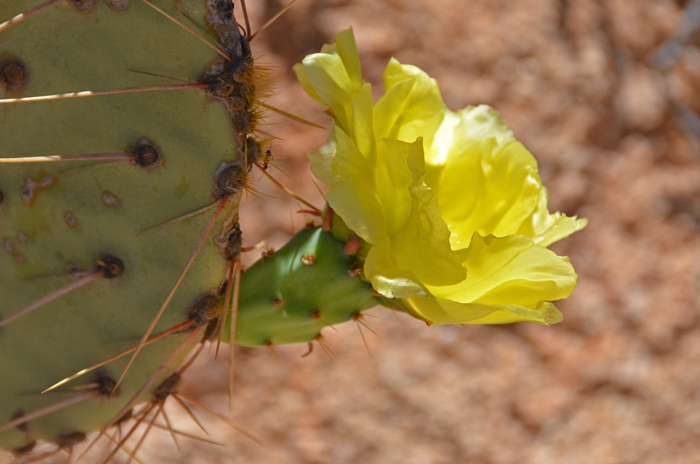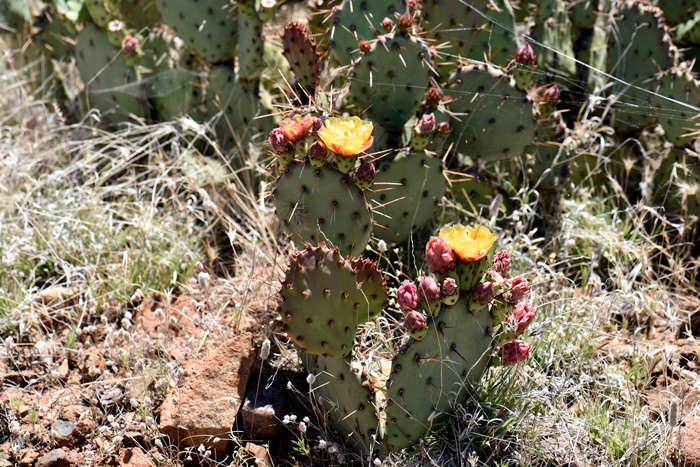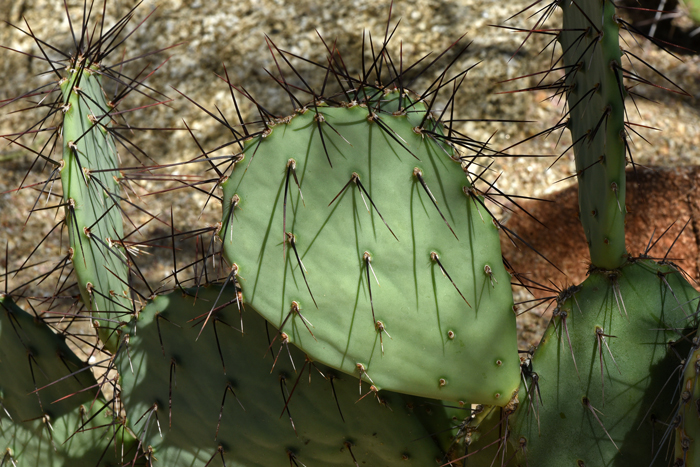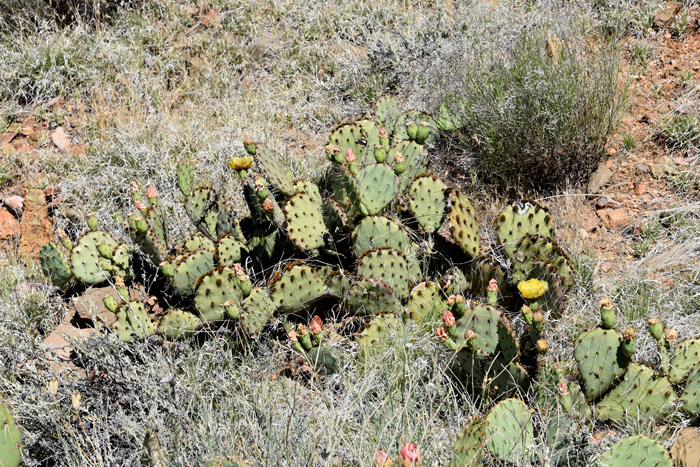Opuntia phaeacantha, Tulip Pricklypear




Scientific Name: Opuntia phaeacantha
Common Name: Tulip Pricklypear
Also Called: Brownspine Prickly Pear Cactus, Brownspine Pricklypear, Brown-spined Prickly Pear, Desert Prickly Pear, New Mexico Prickly Pear, Purple-fruited Prickly Pear, Tulip Prickly Pear (Spanish: Nopal)
Family: Cactaceae, Cactus Family
Synonyms: (Opuntia arizonica, Opuntia canada, Opuntia camanchica, Opuntia charlestonensis, Opuntia dulcis, Opuntia engelmannii var. cycloides, Opuntia gilvescens, Opuntia mojavensis, Opuntia phaeacantha var. brunnea, Opuntia p. var. camanchica, Opuntia p. var. major, Opuntia p. var. mojavensis, Opuntia p. var. nigricans, Opuntia p. var. phaeacantha, Opuntia p. var. superbospina, Opuntia superbospina, Opuntia woodsii)
Status: Native
Duration: Perennial
Size: About 3 tall or less and up to 8 feet wide.
Growth Form: Shrub, Tree; decumbent to commonly trailing, stem segments green to dark green (or reddish under stress) flattened pads or segments, obovate to circular.
Leaves: Leaves modified into spines or glochids and emerging from areoles; spines 0 or 2 to 8 per areole; spines brown to red-brown to black, spines usually flattened near the base; glochids in dense crescent, tan to red-brown.
Flower Color: Yellow, inner tepals yellow with red basal portions; filaments greenish basally, pale yellow to white distally; anthers yellow; style white; stigma lobes green to yellow-green; fruits wine red to purple with greenish flesh, somewhat juicy, obovate to barrel-shaped, fleshy, glabrous, spine-less.
Flowering Season: April to July.
Elevation: 2,000 to 7,000 feet.
Habitat Preferences: Sandy to rocky hills, flats, valleys, canyons, mountains and plains; various habitats; deserts, chaparral.
Recorded Range: Opuntia phaeacantha is found mostly in the southwest quarter of the United States in AZ, CA, CO, KS, NM, NV, OK, SD, TX and UT. It is also native throughout Baja California and Mexico. In Arizona it is found throughout much of the states few or no records for Yuma, Co.
North America & US County Distribution Map for Opuntia phaeacantha.
U.S. Weed Information: No information available.
Invasive/Noxious Weed Information: No information available.
Wetland Indicator: No information available.
Threatened/Endangered Information: Arizona: Opuntia phaeacantha, Tulip Pricklypear is salvage restricted: Nevada: Opuntia phaeacantha, Tulip Pricklypear is Protected as a Cactus, Yucca, or Christmas tree.
Genus Information: In North America there are 52 species for Opuntia. Worldwide, The Plant List includes 194 accepted species names and a further 203 scientific names of infraspecific rank for the genus.
In the Southwestern United States: Arizona has 16 species of Opuntia, California and Utah each have 10 species, Nevada has 6 species, New Mexico has 13 species, Texas has 23 species. All data is approximate and subject to taxonomic changes.
Comments: Early Tulip Pricklypear plants and some varieties were classified as Cactus Apple, Opuntia engelmannii, for which this species might be confused with as a similar looking species.
In Southwest Desert Flora also see: Beavertail Pricklypear, Opuntia basilaris; Cactus Apple, Opuntia engelmannii; Long-spined Prickly Pear, Opuntia macrocentra; Twistspine Pricklypear, Opuntia macrorhiza and Santa Rita Pricklypear, Opuntia santa-rita.
Tulip Pricklypear has been used for food by southwestern United States indigenous peoples.
See complete listing of ethno-botanical uses at Native American Ethnobotany, University of Michigan, Dearborn.

